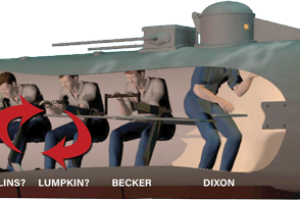(April 13, 2004 – CHARLESTON, SC) – We only know his last name. Perhaps in his early forties, Lumpkin was one of the oldest crewmembers of the H. L. Hunley and sat at the second crank position. Currently, little is known about him, except the strenuous lifestyle the forensic analysis points to.
He was European born but had been away from Europe for many years before manning the world’s first successful combat submarine. “He had been away from his home almost the longest of any of the crew,” says Doug Owsley, a forensic scientist at the Smithsonian Institution.
Standing 5 foot 10 inches and approximately 37 – 44 years in age, Lumpkin’s main duty on the Hunley was manual cranking, and his remains indicate most of his life was spent the same way, with a long history of strenuous physical work.
An examination of his remains confirms that Lumpkin suffered from arthritis, back aches, and walked with a slouch. He had broken several bones throughout his life including his nose, cheek, and foot. These injuries could have been sustained during a battle, an accident or a fist fight. Regardless of the cause, he no doubt had experienced his fair share of pain and physical stress and was prepared for the difficult work he would encounter on the Hunley.
Lumpkin was an avid smoker and had worn notches in his teeth where he cradled his pipe. Out of habit, he even carried his pipe onboard the Hunley, though he would not have been able to smoke inside. Other personal items found next to Lumpkin were a sewing kit and pocketknife.
After the outbreak of the War, Lumpkin probably served onboard the CSS Indian Chief, the ship of origin for four other Hunley crewmembers. Dixon apparently had his choice of crewmembers from the Indian Chief, and must have been drawn to experienced seaman or physical strength. Lumpkin, like the rest of the crew, would have volunteered for service.
Some have speculated that this Hunley crewmember may have been named Simpkins, but forensic genealogist Linda Abrams says his name was most likely Lumpkin. She has found a Confederate States Navy Pay Roster from October 1863 that lists C. Lumpkins. Also, there is a handwritten note by William Alexander, one of the Hunley’s builders, that states a Lumpkin worked onboard the submarine.
“I feel confident this man’s name was Lumpkin or Lumpkins,” Abrahams said.
Even though there is still uncertainty on this crewmember’s name and little information on his personal life, his contribution and sacrifice to maritime history will not be forgotten.
On the evening of February 17, 1864, the H. L. Hunley became the world’s first successful combat submarine by sinking the USS Housatonic. After signaling to shore that the mission had been accomplished, the submarine and her crew of eight vanished.
Lost at sea for over a century, the Hunley was located in 1995 by Clive Cussler’s National Underwater Agency (NUMA). The hand-cranked vessel was raised in 2000 and delivered to the Warren Lasch Conservation Center, where an international team of scientists are at work conserving the vessel and piecing together clues to solve the mystery of her disappearance.
The Hunley project scientific staff worked with forensic expert Doug Owsley of the Smithsonian Institution and forensic genealogist Linda Abrams to identify the remains of the Hunley crewmembers. They did this by combining the archaeological and genealogical information with the osteological analysis of the skeletal remains. For example, the remains can tell us the age range and region of origin for each crewmember. If the genealogical information on age and birthplace match the forensic data, they can estimate the crewmember’s identity through the process of elimination. However, a completely positive identification of each crewmember can only come from a DNA match with a descendant.


